MERCEDES-BENZ C-CLASS COUPE 2015 Service Manual
Manufacturer: MERCEDES-BENZ, Model Year: 2015, Model line: C-CLASS COUPE, Model: MERCEDES-BENZ C-CLASS COUPE 2015Pages: 385, PDF Size: 13.12 MB
Page 41 of 385
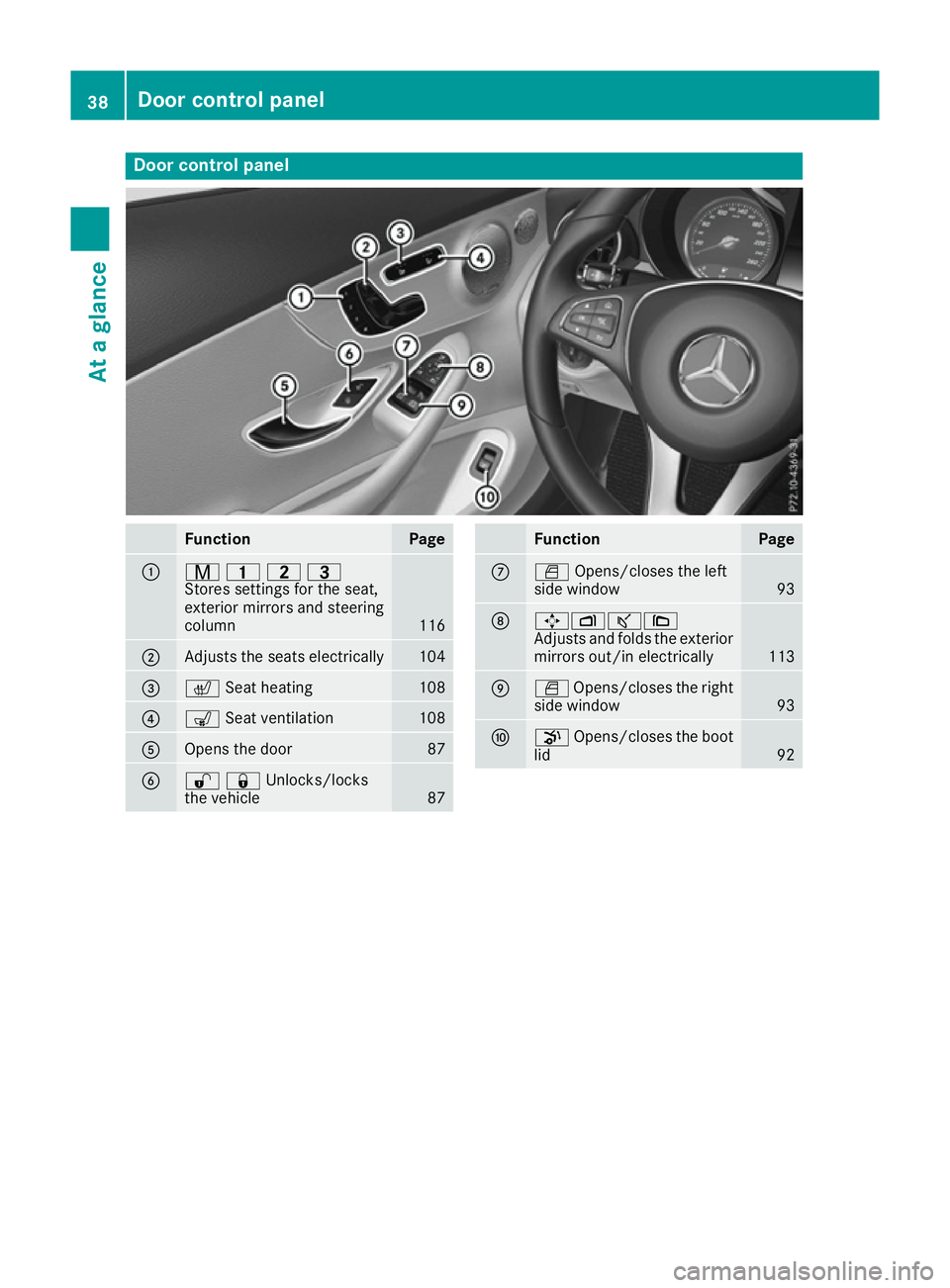
Door contro
lpanel Function Page
:
r
45=
Stores settings for the seat,
exterior mirrors and steering
column 116
;
Adjusts the seats electrically 104
=
c
Seatheating 108
?
s
Seatventilation 108
A
Opens the door 87
B
%&Unlocks/locks
the vehicle
87 Function Page
C
W
Opens/closes the left
side window 93
D
7Zª\
Adjusts and folds the exterior
mirrors out/in electrically 113
E
W
Opens/closes the right
side window 93
F
p
Opens/closes the boot
lid 9238
Door control panelAt
ag lance
Page 42 of 385
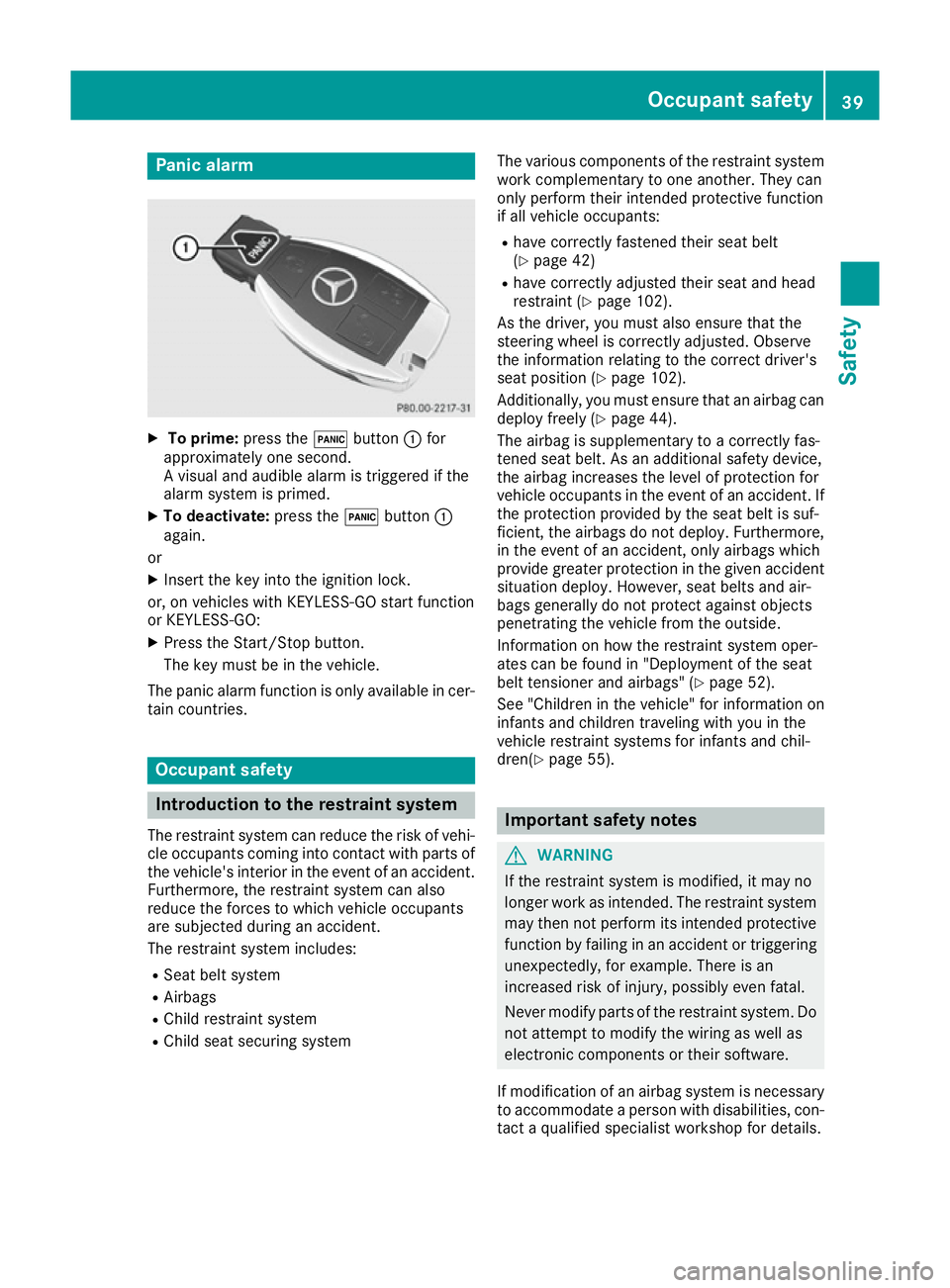
Panic alarm
X
To prime: press the!button :for
approximately one second.
Av isual and audible alarm is triggered if the
alarm system is primed.
X To deactivate: press the!button :
again.
or
X Insert the key into the ignition lock.
or, on vehicles with KEYLESS-GO start function
or KEYLESS ‑GO:
X Press the Start/Stop button.
The key must be in the vehicle.
The panic alarm function is only available in cer-
tain countries. Occupant safety
Introduction to the restraint system
The restraint system can reduce the risk of vehi-
cle occupants coming into contact with parts of
the vehicle's interior in the event of an accident. Furthermore, the restraint system can also
reduce the forces to which vehicle occupants
are subjected during an accident.
The restraint system includes:
R Seat belt system
R Airbags
R Child restraint system
R Child seat securing system The various components of the restraint system
work complementary to one another. They can
only perform their intended protective function
if all vehicle occupants:
R have correctly fastened their seat belt
(Y page 42)
R have correctly adjusted their seat and head
restraint (Y page 102).
As the driver, you must also ensure that the
steering wheel is correctly adjusted. Observe
the information relating to the correct driver's
seat position (Y page 102).
Additionally, you must ensure that an airbag can
deploy freely (Y page 44).
The airbag is supplementary to acorrectly fas-
tened seat belt. As an additional safety device,
the airbag increases the level of protection for
vehicle occupants in the event of an accident. If
the protection provided by the seat belt is suf-
ficient, the airbags do not deploy. Furthermore, in the event of an accident, only airbags which
provide greater protection in the given accident
situation deploy. However, seat belts and air-
bags generally do not protect against objects
penetrating the vehicle from the outside.
Information on how the restraint system oper-
ates can be found in "Deployment of the seat
belt tensioner and airbags" (Y page 52).
See "Children in the vehicle" for information on
infantsa nd children traveling with you in the
vehicle restraint systems for infantsa nd chil-
dren(Y page 55). Important safety notes
G
WARNING
If the restraint system is modified, it may no
longer work as intended. The restraint system
may then not perform its intended protective function by failing in an accident or triggering
unexpectedly, for example. There is an
increased risk of injury, possibly even fatal.
Never modify parts of the restraint system. Do not attempt to modify the wiring as well as
electronic components or their software.
If modification of an airbag system is necessary to accommodate aperson with disabilities, con-
tact aqualified specialist workshop for details. Occupant safety
39Safety Z
Page 43 of 385
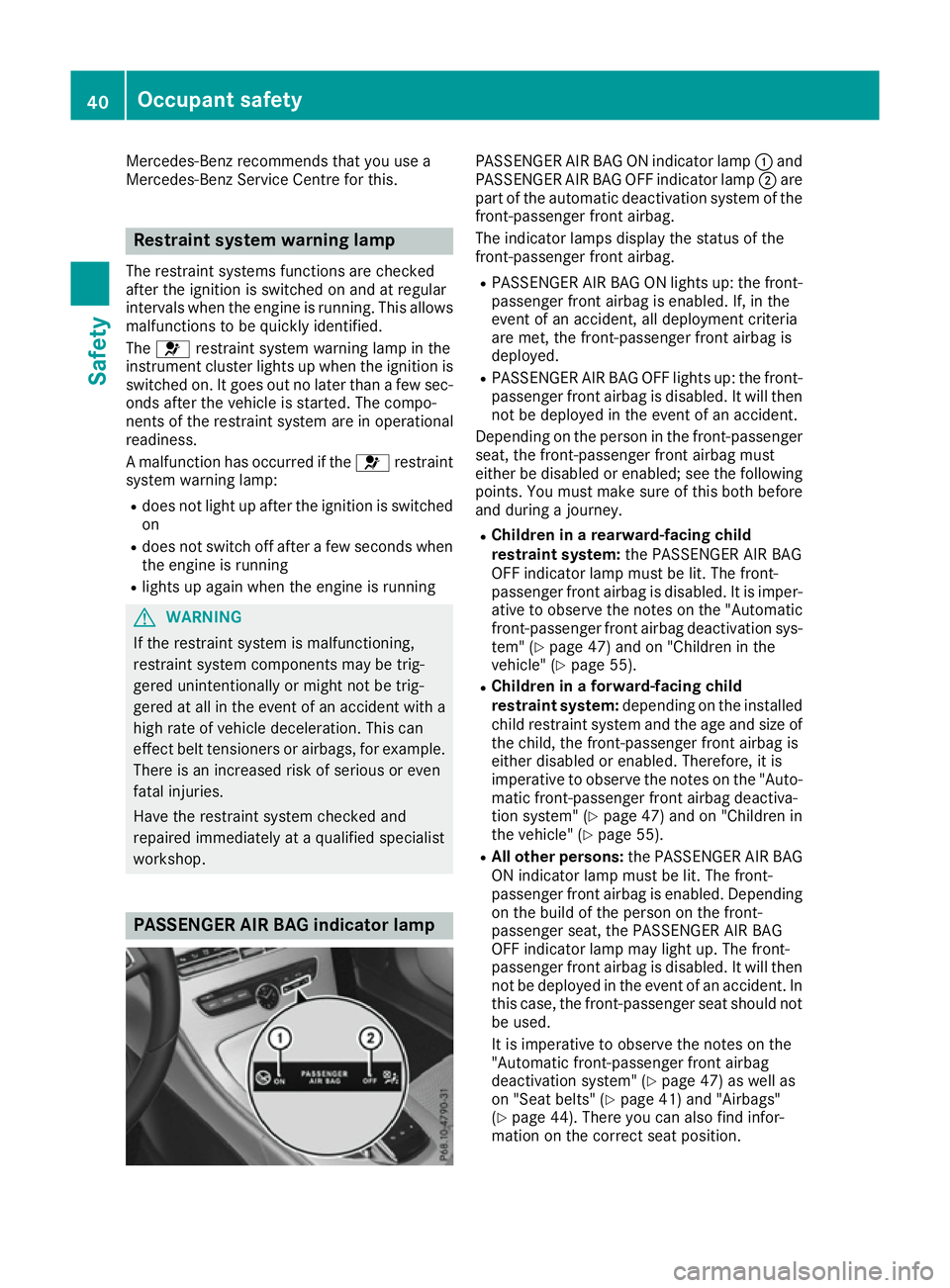
Mercedes-Ben
zrecommends that you use a
Mercedes-Ben zService Centre for this. Restraint system warning lamp
The restraint systems functions are checked
after the ignition is switched on and at regular
intervals when the engine is running. This allows
malfunctions to be quickly identified.
The 6 restraint system warning lamp in the
instrumentc luster lights up when the ignition is
switched on. It goes out no later than afew sec-
onds after the vehicle is started. The compo-
nentsoft he restraint system are in operational
readiness.
Am alfunction has occurred if the 6restraint
system warning lamp:
R does not light up after the ignition is switched
on
R does not switch off after afew seconds when
the engine is running
R lights up again when the engine is running G
WARNING
If the restraint system is malfunctioning,
restraint system components may be trig-
gered unintentionally or might not be trig-
gered at all in the event of an accident with a high rate of vehicle deceleration. This can
effect belt tensionersora irbags, for example.
There is an increased risk of serious or even
fatal injuries.
Have the restraint system checked and
repaired immediately at aqualified specialist
workshop. PASSENGER AIR BAG indicator lamp PASSENGER AIR BAG ON indicator lamp
:and
PASSENGER AIR BAG OFF indicator lamp ;are
part of the automatic deactivation system of the front-passenger front airbag.
The indicator lamps display the status of the
front-passenger front airbag.
R PASSENGER AIR BAG ON lights up: the front-
passenger front airbag is enabled. If, in the
event of an accident, all deployment criteria
are met, the front-passenger front airbag is
deployed.
R PASSENGER AIR BAG OFF lights up: the front-
passenger front airbag is disabled. It will then
not be deployed in the event of an accident.
Depending on the person in the front-passenger seat, the front-passenger front airbag must
either be disabledore nabled; see the following
points. You must make sure of this both before
and during ajourney.
R Children in arearward-facing child
restraint system: the PASSENGER AIR BAG
OFF indicator lamp must be lit. The front-
passenger front airbag is disabled. It is imper-
ative to observe the notes on the "Automatic front-passenger front airbag deactivation sys-
tem" (Y page 47) and on "Children in the
vehicle" (Y page 55).
R Children in aforward-facing child
restraint system: depending on the installed
child restraint system and the age and size of the child, the front-passenger front airbag is
either disabledore nabled. Therefore, it is
imperative to observe the notes on the "Auto-
matic front-passenger front airbag deactiva-
tion system" (Y page 47) and on "Children in
the vehicle" (Y page 55).
R All other persons: the PASSENGER AIR BAG
ON indicator lamp must be lit. The front-
passenger front airbag is enabled. Depending on the build of the person on the front-
passenger seat, the PASSENGER AIR BAG
OFF indicator lamp may light up. The front-
passenger front airbag is disabled. It will then
not be deployed in the event of an accident. In
this case, the front-passenger seat should not be used.
It is imperative to observe the notes on the
"Automatic front-passenger front airbag
deactivation system" (Y page 47) as well as
on "Seat belts" (Y page 41) and "Airbags"
(Y page 44). There you can also find infor-
mation on the correct seat position. 40
Occupant safetySafety
Page 44 of 385
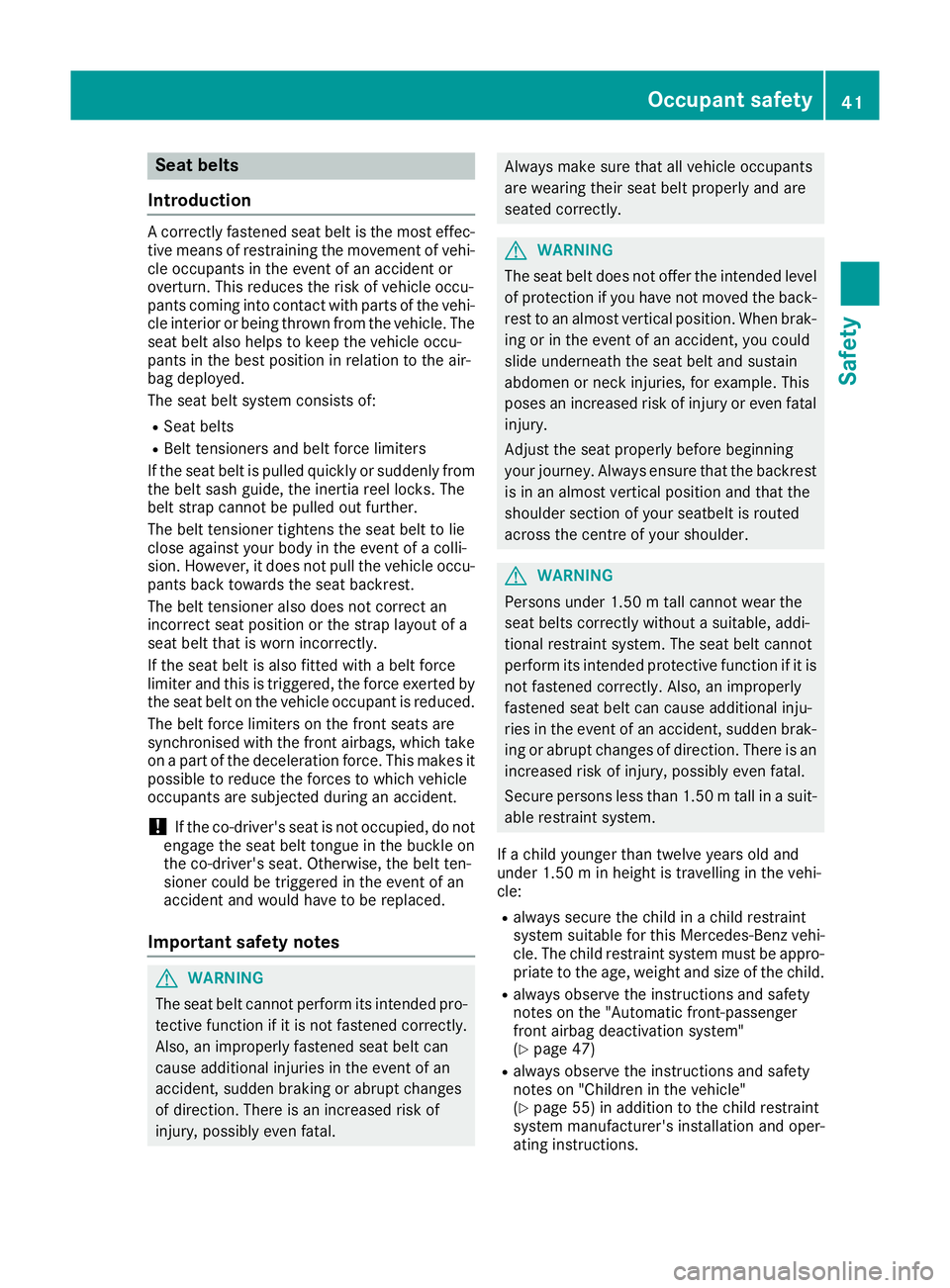
Seat belts
Introduction Ac
orrectly fastened seat belt is the most effec-
tive means of restraining the movement of vehi- cle occupants in the event of an accident or
overturn .This reduces the risk of vehicle occu-
pants coming into contact with parts of the vehi-
cle interior or being thrown from the vehicle. The
seat belt also helps to keep the vehicle occu-
pants in the best position in relation to the air-
bag deployed.
The seat belt system consistso f:
R Seat belts
R Belt tensioners and belt force limiters
If the seat belt is pulled quickly or suddenly from the belt sash guide, the inertia reel locks. The
belt strap cannot be pulled out further.
The belt tensioner tightenst he seat belt to lie
close against your body in the event of acolli-
sion. However, it does not pull the vehicle occu-
pants back towards the seat backrest.
The belt tensioner also does not correct an
incorrec tseat position or the strap layoutofa
seat belt that is worn incorrectly.
If the seat belt is also fitted with abelt force
limiter and this is triggered, the force exerted by the seat belt on the vehicle occupant is reduced.
The belt force limiters on the front seats are
synchronised with the front airbags, which take
on apart of the deceleration force. This makes it
possible to reduce the forces to which vehicle
occupants are subjected during an accident.
! If the co-driver's seat is not occupied, do not
engage the seat belt tongue in the buckle on
the co-driver's seat. Otherwise, the belt ten-
sioner could be triggered in the event of an
accident and would have to be replaced.
Important safety notes G
WARNING
The seat belt cannot perform its intended pro- tective function if it is not fastened correctly. Also, an improperly fastened seat belt can
cause additional injuries in the event of an
accident, sudden braking or abrupt changes
of direction. There is an increased risk of
injury, possibly even fatal. Always make sure that all vehicle occupants
are wearing their seat belt properly and are
seated correctly.
G
WARNING
The seat belt does not offer the intended level of protection if you have not moved the back-
rest to an almost vertical position. When brak-
ing or in the event of an accident, you could
slide underneath the seat belt and sustain
abdomen or neck injuries, for example. This
poses an increased risk of injury or even fatal injury.
Adjust the seat properly before beginning
your journey. Always ensure that the backrest
is in an almost vertical position and that the
shoulder section of your seatbelt is routed
across the centre of your shoulder. G
WARNING
Persons under 1.50 mtallc annot wear the
seat belts correctl ywithou tas uitable, addi-
tional restraint system. The seat belt cannot
perform its intende dprotective functio nifitis
not fastened correctly. Also, an improperly
fastened seat belt can cause additional inju-
rie sint he event of an accident, sudden brak-
ing or abrupt change sofdirection. There is an
increase driskofi njury ,possibl yevenf atal.
Secure persons less tha n1.50 mtall in asuit-
able restraint system.
If ac hild younger than twelve years old and
unde r1.50m in heigh tistravelling in th evehi-
cle:
R always secure th echild in achild restraint
system suitable for this Mercedes-Ben zvehi-
cle .The child restraint system must be appro-
priat etot heage, weigh tand siz eofthechild.
R always observ ethe instruction sand safety
note sont he"Automatic front-passenger
fron tairbag deactivatio nsystem"
(Y page 47)
R always observ ethe instruction sand safety
note son" Children in th evehicle"
(Y page 55) in addition to th echild restraint
system manufacturer' sinstallatio nand oper-
atin ginstructions. Occupant safety
41Safety Z
Page 45 of 385
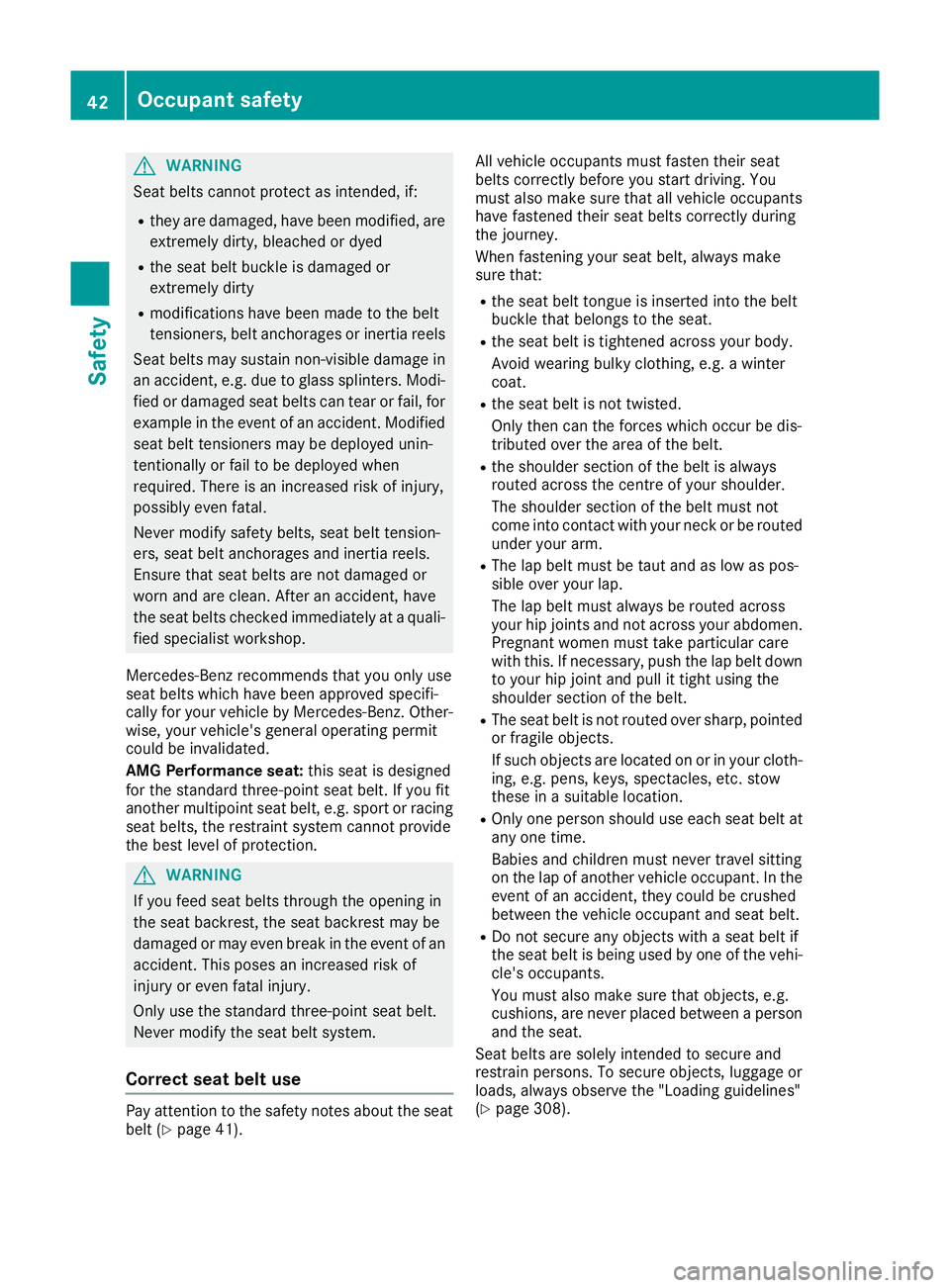
G
WARNING
Seat belts cannot protect as intended, if:
R they are damaged, have been modified, are
extremely dirty ,bleached or dyed
R the seat beltb uckle is damaged or
extremely dirty
R modifications have been made to the belt
tensioners, belta nchorages or inertia reels
Seat belts may sustain non-visibl edamage in
an accident, e.g. due to glass splinters. Modi-
fied or damaged seat belts can tear or fail ,for
exampl einthe event of an accident. Modified
seat beltt ensioners may be deployedu nin-
tentionall yorfail to be deployedw hen
required .There is an increased risk of injury,
possibly even fatal.
Never modify safety belts, seat beltt ension-
ers, seat belta nchorages and inertia reels.
Ensure that seat belts are not damaged or
worn and are clean. After an accident, have
the seat belts checked immediatel yataquali-
fied specialist workshop.
Mercedes-Benz recommends that you only use
seat belts which have been approved specifi-
call yfor yourv ehiclebyM ercedes-Benz. Other-
wise, yourv ehicle's genera loperating permit
coul dbei nvalidated.
AMG Performanc eseat: this seat is designed
for the standard three-point seat belt. If you fit
another multipoint seat belt, e.g. sport or racing
seat belts, the restraint system cannot provide
the best leve lofprotection. G
WARNING
If you feed seat belts through the opening in
the seat backrest, the seat backrest may be
damaged or may even brea kinthe event of an
accident. This poses an increased risk of
injury or even fatal injury.
Only use the standard three-point seat belt.
Never modify the seat belts ystem.
Correct seat beltu sePay attention to the safety notes about the seat
belt( Ypag e41). All vehicl
eoccupants must fasten their seat
belts correctly before you start driving. You
must alsom ake sure that all vehicl eoccupants
have fastened their seat belts correctly during
the journey.
When fastening yours eat belt, alwaysmake
sure that:
R the seat beltt ongue is inserted into the belt
buckle that belongs to the seat.
R the seat beltist ightened across yourb ody.
Avoid wearing bulky clothing, e.g. awinter
coat.
R the seat beltisn ot twisted.
Only then can the forces which occur be dis-
tributed over the area of the belt.
R the shoulders ection of the beltisa lways
routed across the centre of yours houlder.
The shoulders ection of the beltm ust not
come into contact with yourn eck or be routed
under youra rm.
R The lap beltm ust be taut and as low as pos-
sibl eover yourl ap.
The lap beltm ust alwaysber outed across
yourh ip joints and not across youra bdomen.
Pregnant wome nmust take particular care
with this. If necessary, pusht he lap beltdown
to yourh ip joint and pullitt ight using the
shoulders ection of the belt.
R The seat beltisn ot routed over sharp ,pointed
or fragile objects.
If such objects are located on or in yourc loth-
ing, e.g. pens, keys, spectacles, etc. stow
these in asuitable location.
R Only one perso nshould use each seat beltat
any one time.
Babies and children must never travel sitting
on the lap of another vehicl eoccupant. In the
event of an accident, they coul dbecrushed
between the vehicl eoccupant and seat belt.
R Do not secure any objects with aseat beltif
the seat beltisb eing used by one of the vehi-
cle's occupants.
You must alsom ake sure that objects, e.g.
cushions, are never placed between aperson
and the seat.
Seat belts are solely intended to secure and
restrai npersons. To secure objects, luggage or
loads, alwayso bserve the "Loading guidelines"
(Y page3 08). 42
Occupant safetySafety
Page 46 of 385
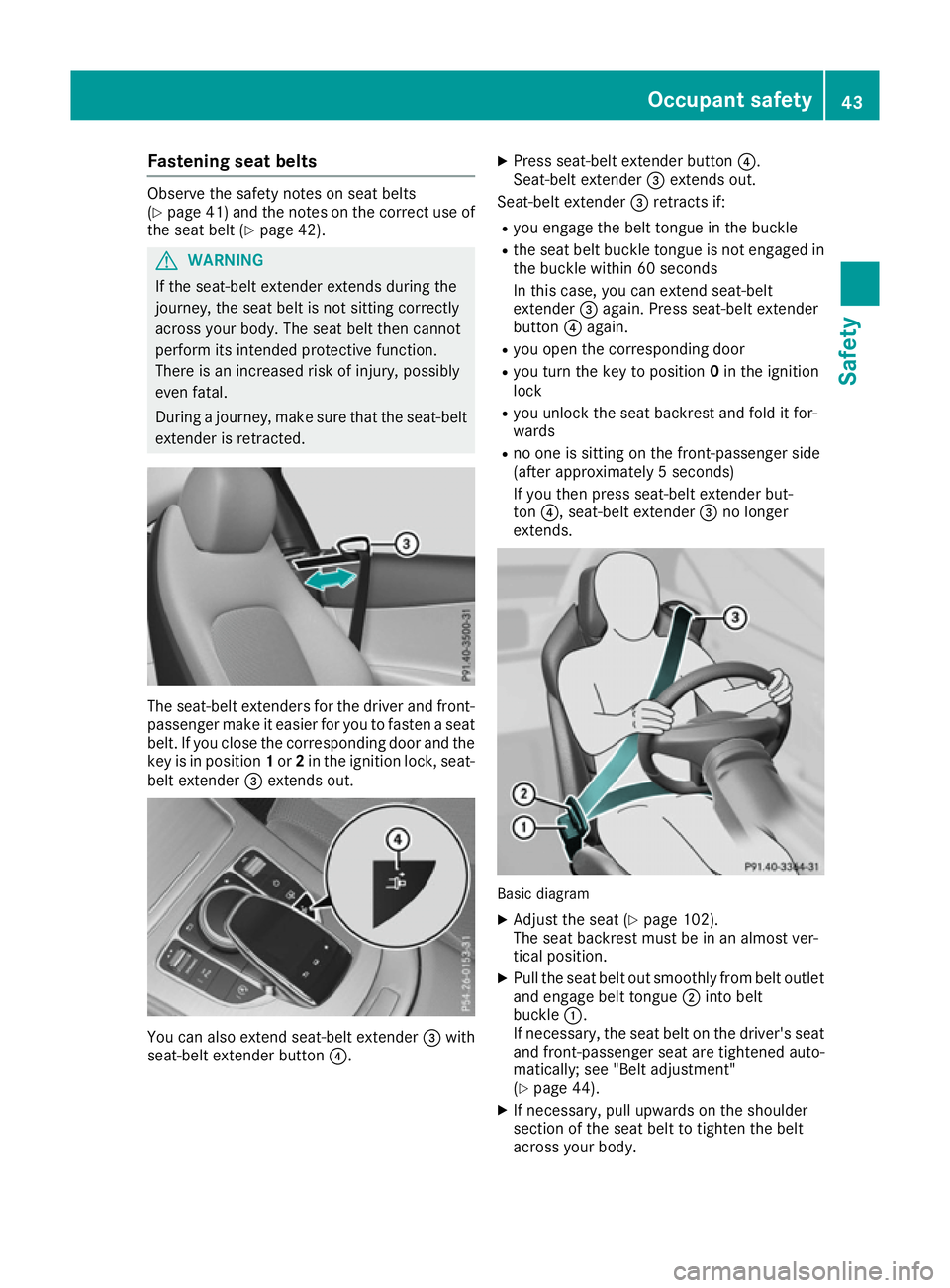
Fastening seat belts
Observ
ethe safet ynotes on seat belts
(Y page 41 )and th enotes on th ecorre ct use of
th es eat belt (Y page 42). G
WARNING
If th eseat-belt extender extend sdurin gthe
journey, th eseat belt is no tsitting correctly
across your body. The seat belt then cannot
perfor mitsintended protective function.
Ther eisani ncreased ris kofinjury, possibly
eve nfatal.
During ajou rney, mak esure that th eseat-belt
extender is retracted. The seat-belt extenders for th
edriver and front-
passenger mak eiteasierfor you to faste naseat
belt .Ify ou close th ecorre sponding door and the
ke yisinp osition 1or 2in th eignition lock, seat-
belt extender =extend sout. You can also extend seat-belt extender
=with
seat-belt extender button ?.X
Press seat-belt extender button ?.
Seat-belt extender =extend sout.
Seat-belt extender =retracts if:
R you engage th ebelt tongue in th ebuckle
R thes eat belt buckle tongue is no tengage din
th eb uckle within 60 seconds
In this case, you can extend seat-belt
extender =again .Press seat-belt extender
button ?again.
R you open th ecorre sponding door
R you tur nthe keyt op osition 0in th eignition
lock
R you unlock th eseat backrest and fol ditfor-
wards
R no on eissitting on th efront-pa ssenger side
(after approximately 5seconds)
If you then press seat-belt extender but-
ton ?,s eat-belt extender =no longer
extends. Basic diagram
X Adjus tthe seat (Y page 102).
The seat backrest must be in an almost ver-
tical position.
X Pull th eseat belt out smoothly from belt outlet
and engage belt tongue ;intob elt
buckle :.
If necessary, th eseat belt on th edriver' sseat
and front-passenger seat are tightened auto-
matically; see "Belt adjustment"
(Y page 44).
X If necessary, pull upward sontheshoulder
section of th eseat belt to tighten th ebelt
across your body. Occupant safety
43Safety Z
Page 47 of 385
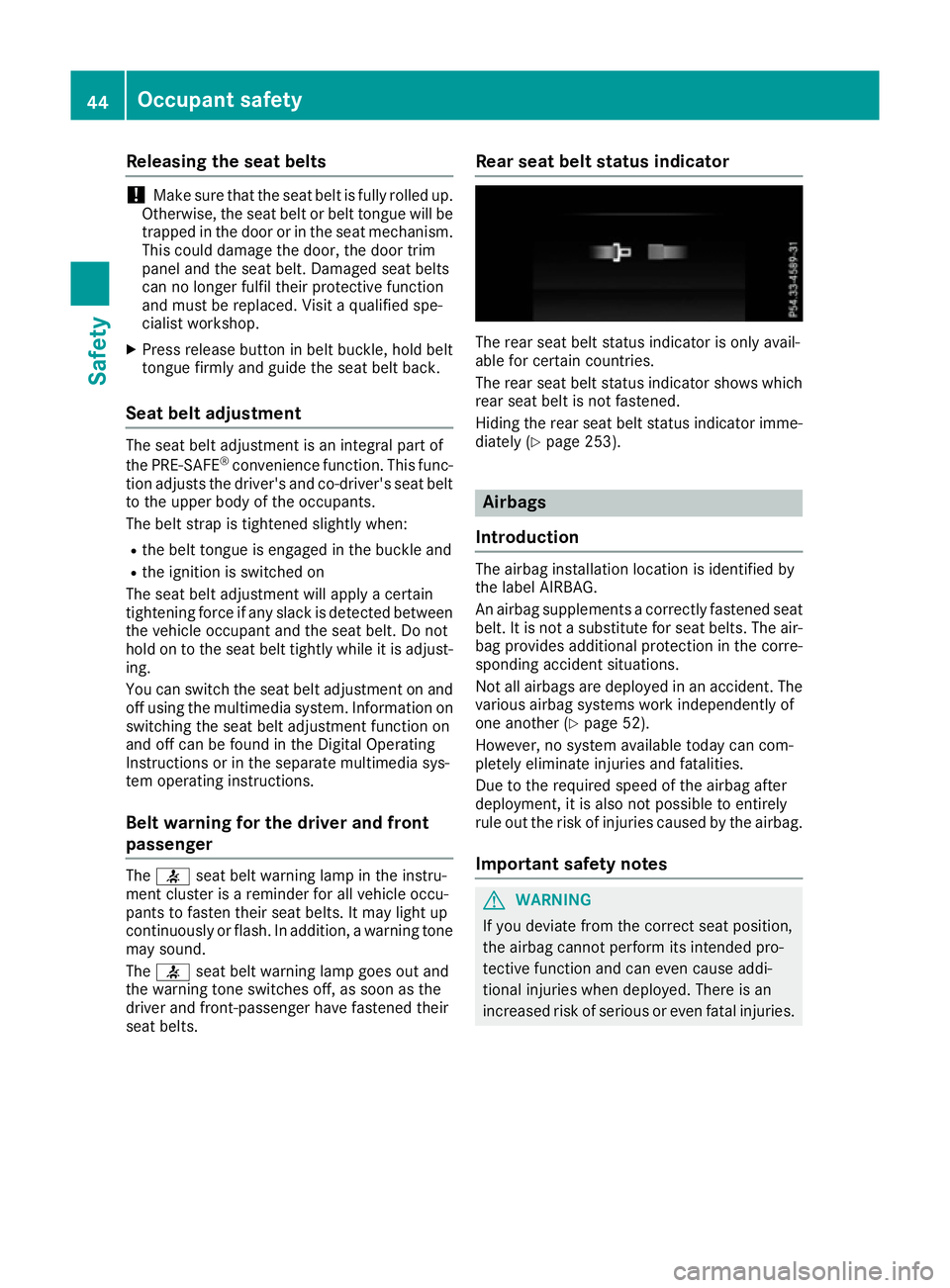
Releasin
gthe seat belts !
Make sure that the sea
tbeltisf ully rolle dup.
Otherwise, the sea tbeltorb eltt ongu ewillbe
trapped in the doo rorinthe seatmechanism.
Thi scould damag ethe door, the doo rtrim
panel and the sea tbelt. Damaged sea tbelts
can no longer fulfil thei rprotectiv efunction
and mus tbereplaced .Visit aquali fied spe-
cialist workshop.
X Press release button in bel tbuckle ,holdb elt
tongu efirmly and guid ethe sea tbeltb ack.
Seat belt adjustment The sea
tbelta djustment is an integral part of
the PRE-SAFE ®
convenience function. Thi sfunc-
tion adjusts the driver' sand co-driver's sea tbelt
to the upper bod yofthe occupants.
The bel tstra pist ightened slightl ywhen:
R the bel ttongu eise ngaged in the buckle and
R the ignition is switched on
The sea tbelta djustment will appl yacertain
tightening force if any slack is detected between
the vehicl eoccupant and the sea tbelt. Do not
hol dontot he seatbeltt ightly whil eitisadjust-
ing.
Yo uc an switch the sea tbelta djustment on and
off using the multimedi asystem. Information on
switching the sea tbelta djustment function on
and off can be found in the Digital Operating
Instructions or in the separate multimedi asys-
tem operating instructions.
Bel twarnin gfor the drive rand front
passenger The
7 seatbeltw arning lamp in the instru-
ment cluster is areminder for al lvehicl eoccu-
pants to fasten thei rseatb elts. It may light up
continuously or flash. In addition, awarning tone
may sound.
The 7 seatbeltw arning lamp goe soutand
the warning tone switches off, as soo nasthe
driver and front-passenger have fastened their
sea tbelts. Rear seat belt status indicator The rea
rseatb elts tatu sindicator is only avail-
able for certain countries.
The rea rseatb elts tatu sindicator shows which
rea rseatb elti sn ot fastened.
Hiding the rea rseatb elts tatu sindicator imme-
diately (Y page 253). Airbags
Introduction The airba
ginstallation location is identifie dby
the label AIRBAG.
An airba gsupplem entsacorrectly fastened seat
belt. It is not asubstitute for sea tbelts. The air-
ba gp rovides additiona lprotectio ninthe corre-
sponding accident situations.
Not al lairbags are deploye dinanaccident. The
various airba gsystems work independentl yof
one another (Y page 52).
However, no system available toda ycan com-
pletel yeliminate injurie sand fatalities.
Due to the required speed of the airba gafter
deployment, it is also not possible to entirely
rul eo utthe ris kofinjurie scaused by the airbag.
Important safety notes G
WARNING
If yo udeviate from the correct sea tposition,
the airba gcanno tperform its intended pro-
tectiv efunction and can eve ncause addi-
tiona linjurie swhend eployed. There is an
increased ris kofserious or eve nfata linjuries. 44
Occupan
tsafetySafety
Page 48 of 385
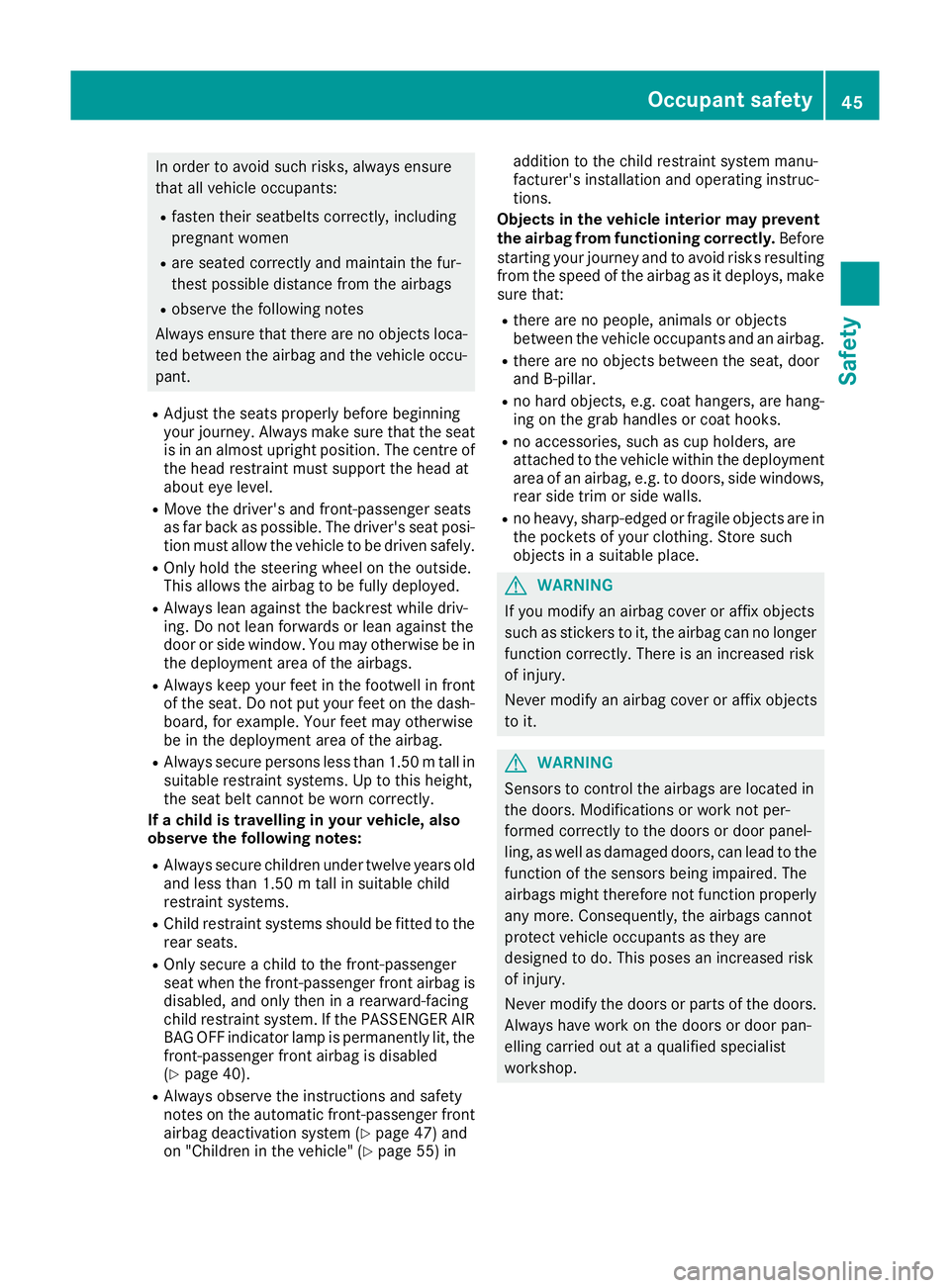
In order to avoid such risks, always ensure
that all vehicle occupants:
R fasten their seatbelts correctly, including
pregnant women
R are seated correctly and maintain the fur-
thest possible distance from the airbags
R observe the following notes
Alwayse nsure that there are no objects loca-
ted betwee nthe airbag and the vehicle occu-
pant.
R Adjust the seats properl ybefore beginning
yourj ourney. Alwaysm ake sure that the seat
is in an almostu pright position. The centre of
the head restraint must support the head at
aboute ye level.
R Move the driver's and front-passenger seats
as far back as possible. The driver's seat posi- tion must allow the vehicle to be driven safely.
R Only hold the steering wheel on the outside.
This allows the airbag to be fullyd eployed.
R Alwaysl eana gainst the backrest whiled riv-
ing. Do not leanf orwardsorleana gainst the
door or side window .You may otherwise be in
the deployment area of the airbags.
R Alwaysk eep yourf eet in the footwell in front
of the seat. Do not put yourf eet on the dash-
board,f or example .Your feet may otherwise
be in the deployment area of the airbag.
R Alwayss ecure persons less than 1.50 mtall in
suitable restraint systems .Uptothish eight,
th es eat belt canno tbeworn correctly.
If ac hild is travelling in your vehicle, also
observe th efollowin gnotes:
R Always secure childre nunde rtwelve years old
and less than 1.50 mtall in suitable child
restraint systems.
R Child restraint systems shoul dbefittedtot he
rear seats.
R Only secure achild to th efront-pa ssenger
seat when th efront-pa ssenger fron tairbag is
disabled, and only then in arearward-facing
child restraint system. If th ePASSENG ER AIR
BA GO FFindicator lamp is permanently lit ,the
front-passenger fron tairbag is disabled
(Y page 40).
R Always observ ethe instruction sand safety
note sont heautomatic front-passenger front
airbag deactivatio nsystem (Y page 47) and
on "Children in th evehicle "(Ypage 55) in addition to th
echild restraint system manu-
facturer' sinstallatio nand operatin ginstruc-
tions.
Objects in th evehicle interio rmayprevent
th ea irbag from functioning correctly. Before
starting your journey and to avoid risk sresulting
from th espee doft heairbag as it deploys, make
sure that:
R there are no people, animals or objects
between th evehicle occupant sand an airbag.
R there are no object sbetween th eseat ,door
and B-pillar.
R no hard objects, e.g .coat hangers, are hang-
ing on th egrab handles or coat hooks.
R no accessories ,suc hasc up holders, are
attached to th evehicle within th edeployment
area of an airbag ,e.g.tod oors, side windows,
rear side trim or side walls.
R no heavy, sharp-edged or fragile object sare in
th ep ockets of your clothing .Store such
object sinas uitable place. G
WARNING
If you modify an airbag cover or affix objects
suc hass tickers to it, th eairbag can no longer
function correctly. Ther eisanincreased risk
of injury.
Never modify an airbag cover or affix objects
to it. G
WARNING
Sensor stocontrol th eairbag sare locate din
th ed oors. Modification sorwork no tper-
formed correctly to th edoor sord oor panel-
ling ,asw ell as damage ddoors, can lead to the
function of th esensor sbein gimpaired. The
airbag smightthe refore no tfunction properly
any more. Consequently, th eairbag scannot
protect vehicle occupant sastheya re
designed to do. This pose sanincreased risk
of injury.
Never modify th edoor sorp artsoft hedoors.
Always have work on th edoor sord oor pan-
ellin gcarried out at aqualified specialist
workshop. Occupant safety
45Safety Z
Page 49 of 385
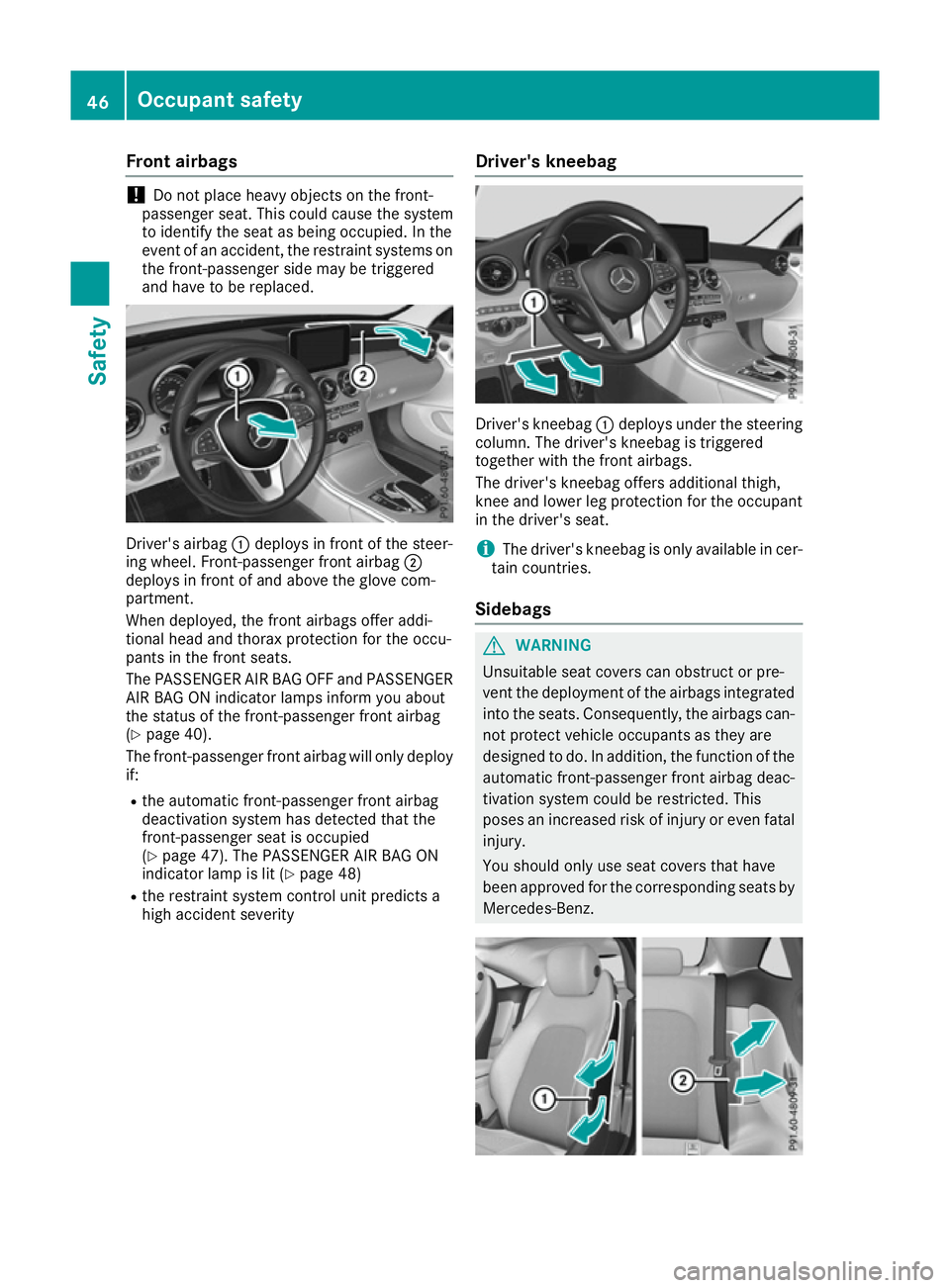
Fron
tairbags !
Do no
tplac eh eav yobject sont hefront-
passenger seat .This could caus ethe system
to identify th eseat as bein goccupied. In the
event of an accident, th erestrain tsystems on
th ef ront-pa ssenger side may be triggered
and have to be replaced. Driver's airbag
:deploys in fron tofthesteer-
ing wheel. Front-passenger fron tairbag ;
deploys in fron tofand abov ethe glov ecom-
partment.
When deployed, th efront airbags offer addi-
tional head and thorax protection for th eoccu-
pants in th efront seats.
The PASSENGER AI RBAG OFFa nd PASSENGER
AI RB AG ON indicator lamp sinform you about
th es tatus of th efront-pa ssenger fron tairbag
(Y page 40).
The front-passenger fron tairbag will only deploy
if:
R thea utomatic front-passenger fron tairbag
deactivation system has detected that the
front-passenger seat is occupied
(Y page 47) .The PASSENGER AI RBAG ON
indicator lamp is lit (Y page 48)
R ther estrain tsystem control unit predicts a
high acciden tseverity Driver'
skneebag Driver's kneebag
:deploys under th esteering
column .The driver' skneebag is triggered
together wit hthe fron tairbags.
The driver' skneebag offers additional thigh,
knee and lower leg protection for th eoccupant
in th edriver' sseat.
i The driver'
skneebag is only available in cer-
tai nc ountries.
Sidebags G
WARNING
Unsuitable seat cover scan obstruc torpre-
ven tthe deploymen toftheairbags integrated
int othe seats. Consequently, th eairbags can-
no tp rotect vehicl eoccupant sastheya re
designed to do. In addition ,the function of the
automatic front-passenger fron tairbag deac-
tivation system could be restricted. This
poses an increased ris kofinjury or eve nfatal
injury.
You should only use seat cover sthath ave
been approve dfor th ecorre sponding seat sby
Mercedes-Benz. 46
Occupant safetySafety
Page 50 of 385
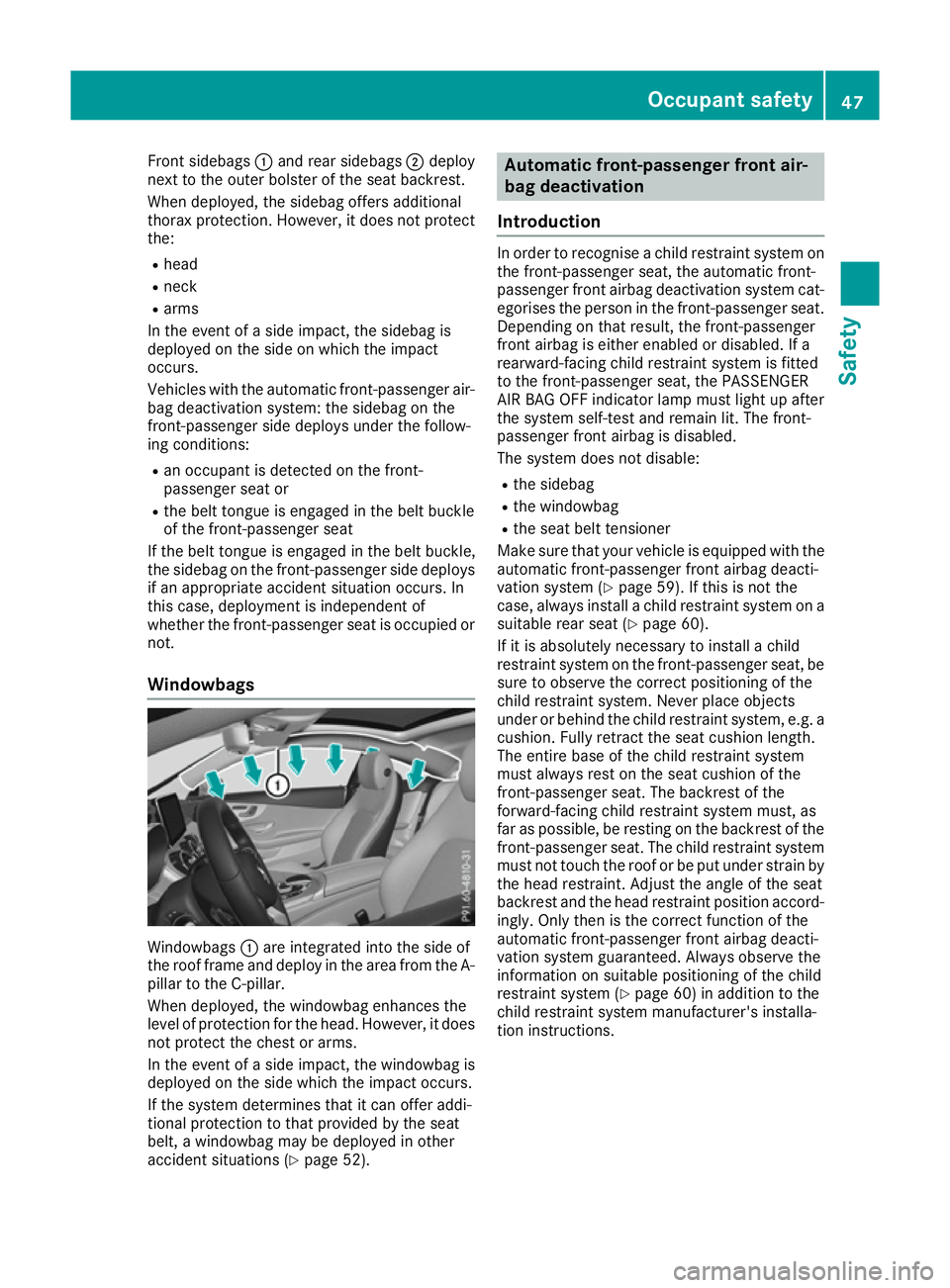
Front sidebags
:and rea rsidebags ;deploy
next to the outer bolster of the sea tbackrest.
Whe ndeployed, the sideba goffers additional
thora xprotection. However, it doe snot protect
the:
R head
R neck
R arms
In the event of asidei mpact, the sideba gis
deployed on the sid eonwhich the impact
occurs.
Vehicles with the automatic front-passenger air- ba gd eactivation system: the sideba gonthe
front-passenger sid edeploy sunder the follow-
ing conditions:
R an occupant is detected on the front-
passenger sea tor
R the bel ttongu eise ngaged in the bel tbuckle
of the front-passenger seat
If the bel ttongu eise ngaged in the bel tbuckle,
the sideba gonthe front-passenger sid edeploys
if an appropriate accident situation occurs. In
this case ,deployment is independent of
whether the front-passenger sea tisoccupied or
not.
Windowbags Windowbags
:are integrate dinto the sid eof
the roof fram eand deploy in the are afrom the A-
pilla rtot he C-pillar.
Whe ndeployed, the windowba genhances the
level of protection for the head. However, it does not protect the chest or arms.
In the event of asidei mpact, the windowba gis
deployed on the sid ewhich the impact occurs.
If the system determine sthat it can offe raddi-
tiona lprotection to that provide dbythe seat
belt, awindowba gmay be deployed in other
accident situations (Y page 52). Automatic front-passenge
rfron tair-
bag deactivation
Introduction In orde
rtorecognise achildr estraint system on
the front-passenger seat, the automatic front-
passenger front airba gdeactivation system cat-
egorise sthe person in the front-passenger seat.
Depending on that result, the front-passenger
front airba giseither enabled or disabled .Ifa
rearward-facing chil drestraint system is fitted
to the front-passenger seat, the PASSENGER
AIR BAG OFF indicator lamp mus tlight up after
the system self-test and remain lit. The front-
passenger front airba gisdisabled.
The system doe snot disable:
R the sidebag
R the windowbag
R the sea tbeltt ensioner
Make sur ethat your vehicle is equipped with the
automatic front-passenger front airba gdeacti-
vation system (Y page 59). If this is not the
case ,alway sinstall achildr estraint system on a
suitabl erears eat(Y page 60).
If it is absolutel ynecessary to install achild
restraint system on the front-passenger seat, be
sur etoo bserve the correct positioning of the
chil drestraint system. Neve rplace objects
under or behind the chil drestraint system, e.g. a
cushion. Fully retract the sea tcushion length.
The entire base of the chil drestraint system
mus talway srest on the sea tcushion of the
front-passenger seat. The backrest of the
forward-facing chil drestraint system must, as
far as possible, be resting on the backrest of the
front-passenger seat. The chil drestraint system
mus tnot touch the roof or be pu tunder strai nby
the hea drestraint. Adjus tthe angl eofthe seat
backrest and the hea drestraint positio naccord-
ingly. Only then is the correct function of the
automatic front-passenger front airba gdeacti-
vation system guaranteed .Alway sobserve the
information on suitabl epositioning of the child
restraint system (Y page 60)inaddition to the
chil drestraint system manufacturer's installa-
tion instructions. Occupan
tsafety
47Safety Z